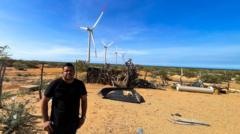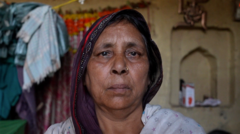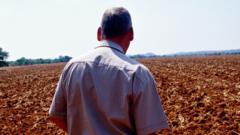As Colombia shifts toward renewable energy, the Wayuu community in La Guajira navigates the promise of improved living conditions against the potential erosion of their cultural identity due to the encroachment of wind farms. While projects like Guajira 1 offer some benefits, concerns about transparency and community division linger, revealing a complex relationship between green energy and indigenous rights.
Wind Power in Colombia: A Double-Edged Sword for Indigenous Wayuu Communities

Wind Power in Colombia: A Double-Edged Sword for Indigenous Wayuu Communities
In La Guajira, Colombia, the transition to wind energy brings both opportunities and challenges for the Wayuu indigenous group, highlighting cultural disruptions and socio-economic disparities.
When José Luis Iguarán steps outside his home in La Guajira, northern Colombia, he is greeted by a line of towering wind turbines that stretch across the arid landscape toward the Caribbean Sea. This region is home to the Wayuu indigenous group, who have inhabited the area for centuries, relying on traditional practices of herding goats, cultivating crops, fishing, and salt mining. With its favorable wind conditions, La Guajira has emerged as a key player in Colombia's shift from fossil fuels to renewable energy. However, this transition is marred by tension and reflection from local residents whose lives are deeply intertwined with their cultural roots and the natural environment.
"You wake up and suddenly you no longer see the trees. Instead, you see and hear the turbines," shares Mr. Iguarán, highlighting the impact of Guajira 1—one of the nation's two operational wind farms—on his community. While the project has provided some benefits, such as access to clean drinking water, better roads, and improved housing, the noise from the turbines disrupts their sacred traditions, particularly their dreams which are seen as a vital connection to their ancestors.
The Wayuu, numbering around 380,000 across Colombia and Venezuela, maintain distinctive customs that shape their collective identity. However, as additional wind farms proliferate—15 more under construction and many more planned—underlying tensions rise within the community. Local fisherman Aaron Laguna explains, "The wind farms produce clean energy, but they create division within the Wayuu communities."
Many residents express concerns over transparency in negotiations and compensation agreements with energy firms. The energy company's payouts have sparked debates over resource management, leading to deeper rifts within families and the wider community.
With a lack of robust legal frameworks to assess environmental and social impacts, these conflicts have exacerbated tensions. Recent incidents have included roadblocks and protests against energy companies, alongside reports of violence and intimidation against workers. "We call it the 'wind wars'," says Joanna Barney, director of environment, energy, and communities at the Colombian think tank Indepaz, stressing the disparity in perspectives between corporate entities and indigenous rights.
Despite the challenges, a portion of the Wayuu community views the energy projects as a potential pathway to development. The Spanish company EDP Renováveis recently suspended plans for two wind farms, driven largely by complaints from local residents which increased from 56 to 113 regarding the need for compensation. Enel, another multinational, departed from its planned project in the area citing continuous protests that halted construction.
For anthropologist Wieldler Guerra, the disconnect between the dreams and cultural values of the Wayuu and the profit-driven motives of the energy companies stems from fundamentally different perceptions of the wind. To the Wayuu, the winds hold spiritual significance and life, while for corporations, they are mere resources for energy production.
As AES Colombia develops the largest wind farm cluster in La Guajira, the company asserts its commitment to maintaining community dialogue and providing essential resources like fresh water. However, AES general manager Federico Echavarría asserts, "We cannot do these projects alone," invoking the need for government involvement to mediate conflicts.
In Cabo de la Vela, where Mr. Laguna resides, the region's neglect by the state is palpable, with inadequate healthcare and education services, as well as a lack of running water. His community longs for expanded facilities that could directly benefit locals from impending wind farms.
Yet, despite the potential for energy advancement and community funding, there is a painful irony—"The worst thing is we won't receive even a single kilowatt of the electricity produced here," Mr. Laguna reflects, indicating that the benefits of wind energy may not extend to the very communities providing the land for its production. As La Guajira invests in a renewable energy future, many Wayuu are left uncertain about their place within it, fearing they might be sidelined in the pursuit of a greener tomorrow.





















